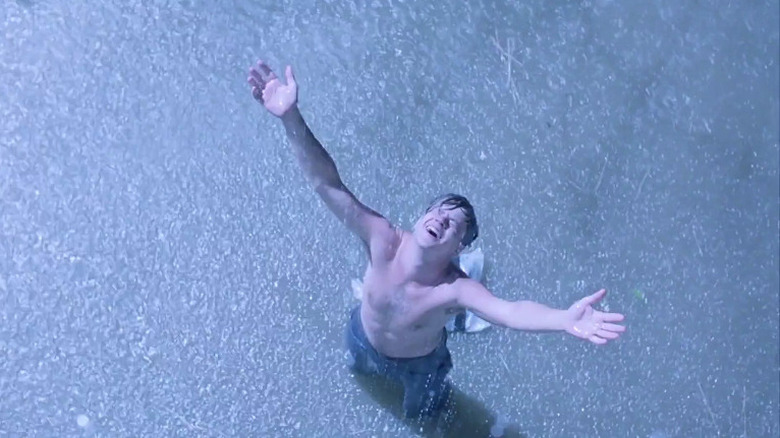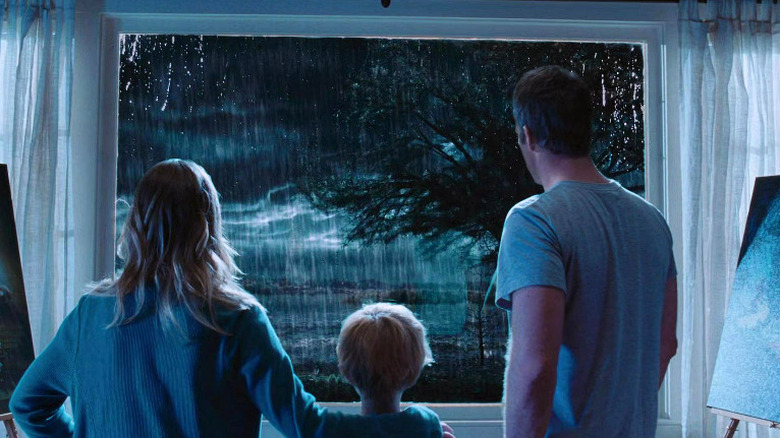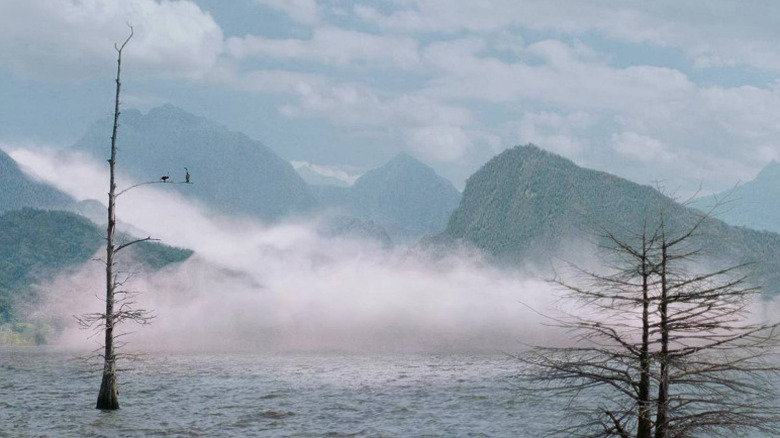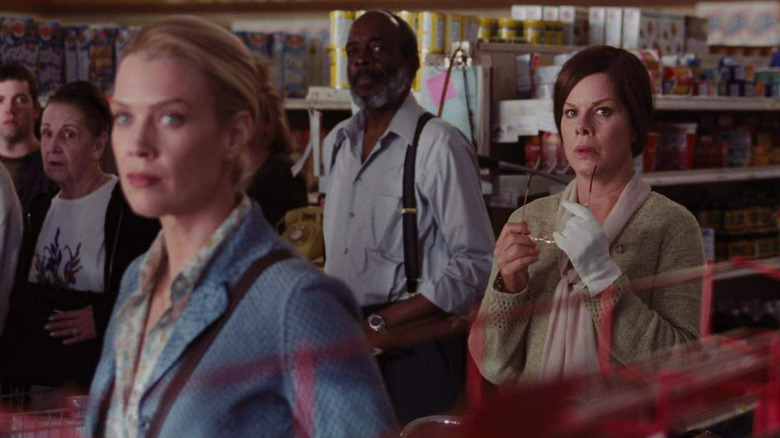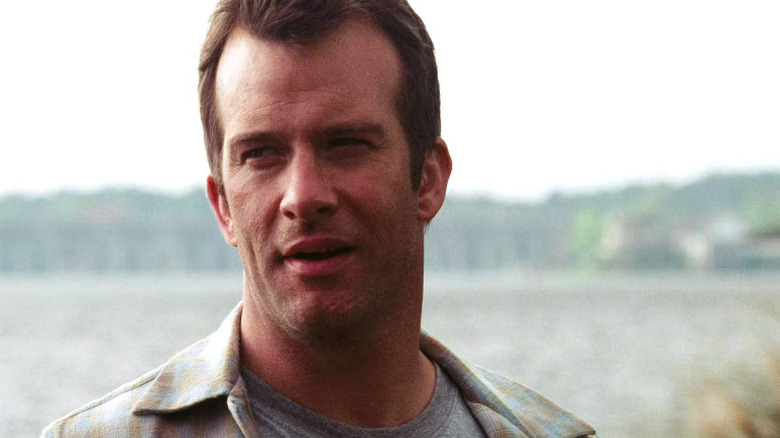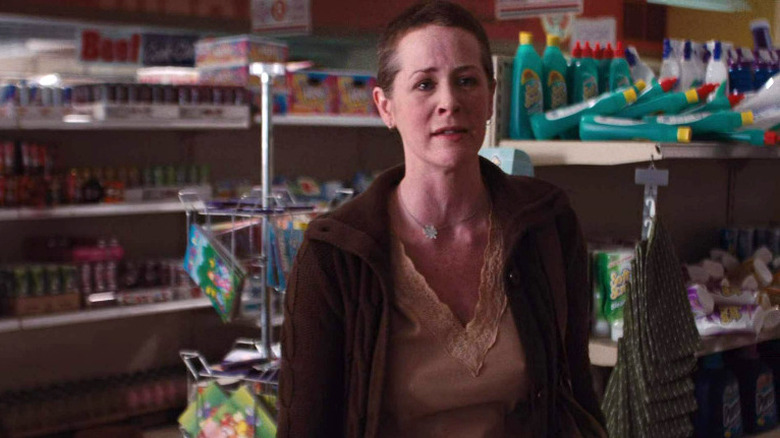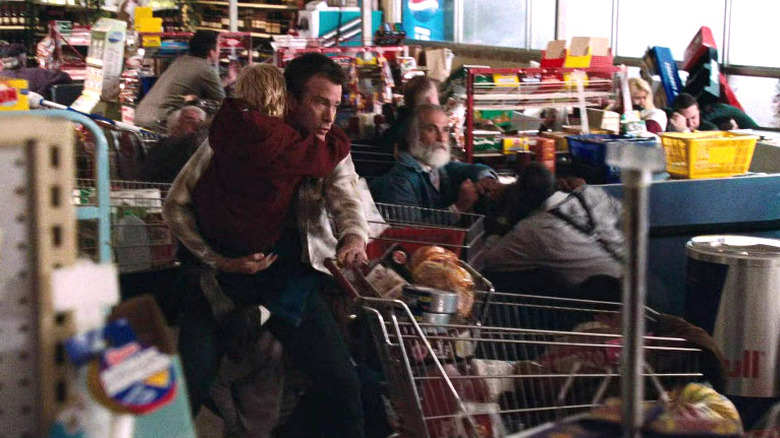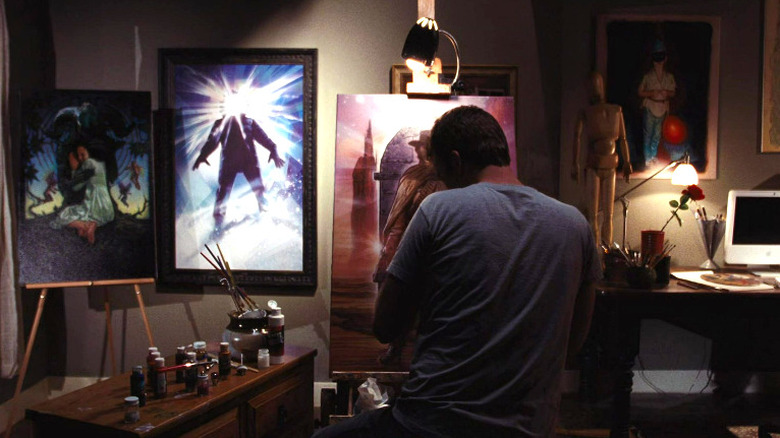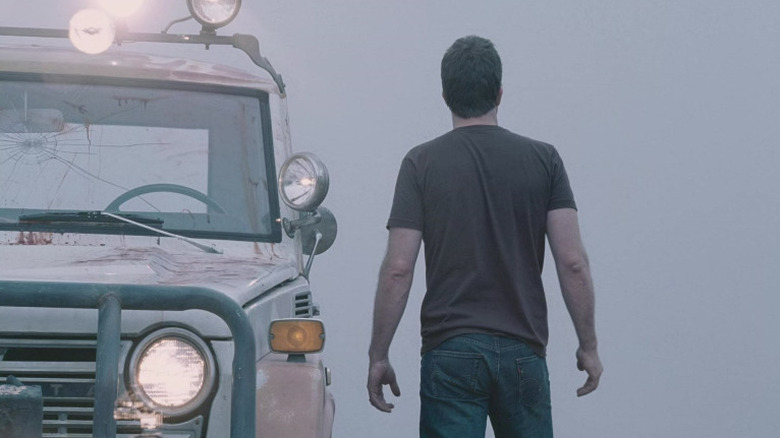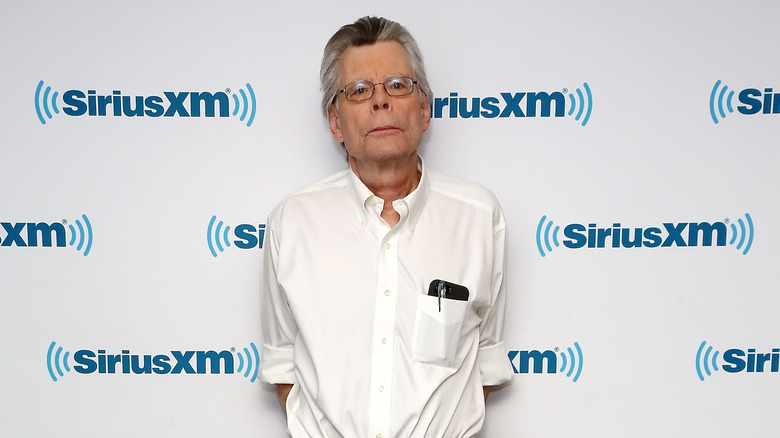The Untold Truth Of The Mist
Thanks to his ability to craft gripping narratives with complex and relatable characters, there have been a ton of movies based on the work of Stephen King. Not all adaptations are created equal, however. Too often, filmmakers choose to focus on the baser elements of his writing rather than pulling from the well of deep characterization, worldbuilding, and universal themes. Usually, these lackluster attempts result in crummy B-movies that fail to stay with you. But sometimes, other adaptations come along that are so true to the source material that not only do they represent the text, they elevate it.
One director with a track record for translating King's stories is Frank Darabont. Beginning with the 1994 masterpiece "The Shawshank Redemption," Darabont has proven time and again that he understands not only why Stephen King stories are so compelling but how to properly bring them to a visual medium. After writing and directing two movies based on King's stories set in prisons, Darabont turned his eye to horror with "The Mist" in 2007.
Unrelenting in its depiction of how societies break down in high-pressure situations, this suspenseful creature feature focuses on the patrons of a small-town supermarket trying to survive an invasion of mysterious monsters traveling through an unnatural mist. All these years later, it remains one of the best and most shocking entries in the Stephen King horror film canon. Now we're taking a look at the making of the film to shine some light on a few details audiences may not be familiar with.
The Mist vs. Shawshank
Early in his career, Frank Darabont was known as a screenwriter. He and writing partner Chuck Russell co-wrote the screenplays for "A Nightmare on Elm Street 3: Dream Warriors" and the 1988 remake of "The Blob" (Russell directed both). He also wrote "The Fly II," some episodes of "Tales from the Crypt" and the "Young Indiana Jones Chronicles," as well as Kenneth Branagh's retelling of "Frankenstein," titled "Mary Shelley's Frankenstein." Obviously, he has an interest in genre stories.
While working on "Dream Warriors" he thought it would be a good idea to have a project he could work on as a director. At the time, he was torn between "The Shawshank Redemption" and "The Mist." In the featurette "When Darkness Came: The Making of The Mist," Darabont said of his decision, "And that night, I kinda decided, 'Shawshank Redemption.' That's a project I then nursed along for about five years, and then, finally, I wrote the script and finally made it." Making the film changed the way Hollywood saw him. "That put me in a whole, sort of, perceptive category of what kind of work I do."
The trajectory of his career certainly changed from that point on. Soon, he was making "The Green Mile" and "The Majestic." Therefore, it may have seemed strange to audiences only familiar with his glossy, feel-good movies that he would then direct something dripping with so much blood and despair as "The Mist."
A different beginning
"The Mist" begins quietly. We see poster artist David Drayton (Thomas Jane) working on a project that's remarkably reminiscent of Stephen King's "The Dark Tower" before the storm outside draws his family's attention. Then, a tree crashes through the window, destroying the man's hard work. The next day, the Draytons spot a mist forming over the water and head to the local supermarket for supplies. While there, that spooky mist rolls into town and traps everyone inside the store.
It's a gradual buildup to the big reveal that something terrifying is lurking in the mist, and it really keeps the tension mounting. But that wasn't always how the film opened. During the audio commentary for the film, Frank Darabont explained his original opening. He compared it to something you might have seen in "The Outer Limits." There's an accident in a military lab, and the mist is released. He wrote it because he thought it was a good idea to explain to the audience where the mist came from.
However, during a dinner with Andre Braugher (who plays skeptical Brent Norton), the actor made a suggestion the director didn't expect. Darabont says Braugher randomly asked him, "Do you think you need that opening scene in the movie?" Darabont thought about it and realized the scene would probably just get cut anyway so there was no point in keeping it. An explanation of the mist's origin is suggested later but never shown or truly explained, keeping the mystery intact.
They made Louisiana look like Maine
During the commentary for "The Mist," Frank Darabont explains that the exterior of David Drayton's home was filmed outside of Shreveport, Louisiana. During the scene when David and his family wake up to find their property has been trashed by the previous night's storm, there's a lot of debris and foliage scattered about. Not only did the filmmakers use all this to create the damage done in the night but to make the area appear a bit more like New England.
With the help of some CGI mountains, the filmmakers managed to create the impression of the story taking place in Maine. This was done so effectively that they fooled Stephen King himself. If you're familiar with the man's writing, you probably know a great deal of his stories (including "The Mist") take place in and around the state of Maine. So to honor the source material, the filmmakers had to recreate the American Northeast in the American South, and according to Darabont, "When Stephen King first saw [the exterior of David's house], he leaned over to me and said, 'Did you shoot this in Maine?'"
A new directing style
If you've seen "The Shawshank Redemption," "The Green Mile," and even "The Majestic," then you know that Frank Darabont has a very precise and cinematic style. Every camera move feels intentional and motivated, each shot tells us something about the characters. "The Mist," on the other hand, is slightly chaotic. The action is happening all around us, and the cameras are always moving, trying to capture it.
That change was intentional. Part of it was due to the film's budget and schedule. Some of it was Darabont deliberately trying something new. While discussing his approach to filming "The Mist" on the audio commentary, he talks about why he was excited to attack the narrative in a different way. "I think it's great to, on occasion, just shake it up," Darabont said. "Just shake up everything that you know and try on a whole different way of doing something — try on a whole different suit of clothes."
In order to do this, he needed to be less of (what he called) a "control freak." He had to loosen up, find things in the moment. As a result, cameras whip around the store, zoom into a bit of action, then move on to something else. There were even moments during shooting when camera operators would turn around and wind up filming each other. All of this went into creating a realism new to his work. He compared the style to a documentary, and there are moments when it feels that way.
Thomas Jane was Darabont's first choice
Thomas Jane had been in one Stephen King adaptation prior to "The Mist." In 2003, he was part of an impressive ensemble cast for a less than impressive big-screen version of King's "Dreamcatcher." The story is like a subpar "It" with childhood friends battling something beyond their understanding as adults. Despite the massive talent of director Lawrence Kasdan and co-writer William Goldman (one of the greatest screenwriters in Hollywood history), the movie failed to connect.
When talking to "The Loser's Club" podcast, Jane said he didn't understand "Dreamcatcher's" script, and he didn't even want to do the movie at first. Even though the film didn't necessarily turn out to his liking, Jane enjoys reading Stephen King stories, and he accepted Frank Darabont's offer to star in "The Mist," which was a thrill for the director.
Early in "The Mist's" commentary, Darabont discusses his relationship with Jane. He was a fan of his work for a long time and explains, "I'd known him somewhat socially, prior to this." Still, they hadn't worked together. When Darabont finished writing "The Mist," Jane was the first actor to read it. Not only did Darabont get his dream casting, but it was a dream experience as well. He said, "I was very happy that he wanted to make this movie. And the experience of working with him was everything I'd hoped it would be. It was really lovely."
Local hires were just as good as the stars
The cast of "The Mist" includes some major heavy hitters, recognizable faces known for delivering great performances. Thomas Jane, of course, is the lead of the film. Previously, he'd appeared in "Boogie Nights" and "Magnolia," in addition to playing Mickey Mantle in the Billy Crystal-directed "61*." Andre Braugher, who plays the big city lawyer, had spent years in the hard-hitting drama series "Homicide: Life on the Streets." Also, Marcia Gay Harden had been in so much that mentioning her credits would take all day.
Then there were the actors Frank Darabont had worked with in the past. Jeffrey DeMunn played Dan Miller, the man warning everyone of what's in the mist. He'd previously been in both "Shawshank" and "The Green Mile." The same is true for William Sadler. Laura Holden had previously starred in "The Majestic" before doing "The Mist," but Frank brought her over to do "The Walking Dead" as well.
So, there was plenty of established talent in the film. That doesn't mean they stole the show, though. There were a few "local" hires (meaning actors living and working in the same geographical region of filming) who really brought the house down. One, in particular, Melissa McBride (who would go on to play Carol in "The Walking Dead") floored everyone with her performance as a woman in need of help. According to Darabont on the commentary, when she was done filming, the entire cast and crew applauded — even the big stars among them.
Classic filming techniques
If there's one element to "The Mist" that doesn't always work, it's the CGI. The scene on the loading dock when they open the door and inadvertently let in a tentacle is particularly rough. It looks like a cartoon rather than the limb of a living creature occupying the same space as our human characters. At least, that is, until they dismember it and the CGI becomes practical.
That's actually emblematic of the entire film. The old-school, practical "movie magic" grounds everything, while the more recent techniques falter. For instance, the market they found for the exterior was so perfect that they recreated the interior on a soundstage. Frank Darabont also mentions in the film's commentary that what we glimpse outside the store window is actually a massive 20 foot by 60 foot digital photograph of the actual store's exterior. These days, productions would probably try to use something like the Volume, a technology pioneered for "The Mandalorian" that allows filmmakers to film photorealistic, digital backgrounds on the set with the actors.
The earthquake scene was also done practically. Instead of artificially shaking the image or lifting the whole set up on a gimbal, the crew simply shook the shelves, shook the cameras, and pulled down the lights. Darabont also said that speakers were brought in and the sounds of an actual earthquake were played. The fact that he didn't tell the actors the sound was coming meant that their reactions were more authentic.
Drew Struzan love
Back when movie posters actually inspired prospective audience members to see a film, artist Drew Struzan was king. Think of any great movie poster that you've seen, and chances are whatever pops to mind was painted by Struzan. "Big Trouble in Little China," "Blade Runner," and the "Star Wars Trilogy Special Edition" are just a few of his masterpieces. He even produced posters for "The Shawshank Redemption" and "The Green Mile."
In the featurette "Drew Struzan: Appreciation of an Artist," Darabont gushes about his work, calling him "one of the three greatest movie poster artists that ever lived." To honor the iconic artist, Frank Darabont decided to base his main character's own work on that of Struzan. When we see David Drayton adding color to the rose hovering beside a gunslinger (who Darabont confirms on the commentary is Roland from a fictitious adaptation of "The Dark Tower"), he's actually working on an original Struzan that was commissioned for the production.
Not only that, but Darabont also points out that David's studio is fashioned on Struzan's personal studio. In the background, we can see posters for Guillermo del Toro's "Pan's Labyrinth" and John Carpenter's "The Thing" — posters Struzan did. In fact, del Toro himself says in "Appreciation of an Artist" that to him, "Every movie that has to be something special, has to have a poster by Drew Struzaan." In the end, Darabont admits, "I thought it was just time for us to acknowledge how much we love Drew Struzan."
The ending was non-negotiable
The ending of Frank Darabont's "Mist" is a real gut punch. The original novella was open-ended. All we know is that the characters who survived are going to continue traveling through the mist until they find something. There's no closure. The movie, on the other hand, delivers a disturbing and deeply unsettling finale that not everyone in the audience is going to be okay with — with David Drayton mercy-killing his friends and son, only for help to arrive and the mist to blow away just seconds later.
What inspired this gruesome climax? When talking to fellow screenwriter and director Mick Garris about "The Mist," Darabont explained that he isn't the fresh-faced, optimistic kid who made "The Shawshank Redemption." "The events of the 21st century have not been to my liking," Darabont said, adding, "I see the game being rigged and re-rigged and re-rigged so many times," which made him wonder, "If we're going to continue to make the same stupid mistakes, then what the hell value is there in our species?"
During a conversation with Stephen King, Darabont mentioned that the film's ending felt natural because King had written a story about how people break down and do terrible things under pressure just to survive. In that same conversation, he explained that before agreeing to make the movie with Dimension Films, he needed studio executive Bob Weinstein to agree to let him do the ending because it was non-negotiable. Thankfully, he got to make exactly the kind of movie he wanted to.
Stephen King loved The Mist
There have been a ton of movies based on Stephen King's books and not all of them are great. King himself doesn't always approve of the movies based on his work either. It's cliche to point out now, but he infamously hates Stanley Kubrick's version of "The Shining." However, there are a few adaptations that King quite enjoys. As pointed out by Dread Central, King writes very favorably of "The Mist" in an updated edition of his non-fiction book about horror, "Danse Macabre." As he put it, "Frank Darabont's vision of hell is completely uncompromising. If you want sweet, the Hollywood establishment will be pleased to serve you at the cineplex, believe me, but if you want something that feels real, come here. Darabont could have made a higher budget film if he'd added a cheerful 'it's okay kiddies' ending, but he refused. His integrity and courage shine in every scene."

